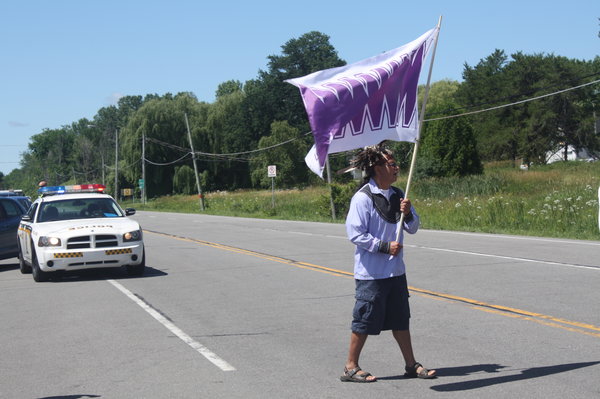Please support our coverage of democratic movements and become a supporting member of rabble.ca.
Nothing has changed. But everything has changed.
That was the refrain at a gathering for the 23rd anniversary of the Oka Crisis and protest of recent oil company representatives in Oka and Kanehsatà:ke.
Nothing has changed in the way natives are treated by the federal government, but everything has changed for people involved in the struggle for indigenous rights, activists told the crowd.
Clifton Nicholas should know. He was in the Pines amongst the warriors during the 78-day standoff between the Mohawk Warrior Society, the Sûreté du Québec, and eventually the Canadian military.
For Nicholas, 18 years old during the standoff, those 78 days from July till September were a turning point. His life is divided into “before and after 1990,” he said.
Now 23 years since the crisis, Nicholas and others in Kanehsatà:ke say many of the issues that brought about the standoff are still unresolved.
Specifically, people in the community here are angry that recent efforts to secure a route to the East Coast for Alberta tar sands oil has seen employees from Gazoduc and TransCanada inspecting a pipeline that runs through Oka.
Ellen Gabriel also played a big part in the Oka Crisis as the chief negotiator for the Mohawks and one of the most recognizable faces from the media coverage of those 78 days.
Now, 23 years later, she still describes the methods of appropriation of Mohawk land here as “coercion.”
The explosion of a train carrying crude oil in Lac-Mégantic this past weekend has ignited a debate about the safety of transporting oil by rail, and oil industry analysts have advocated for the increased use of pipelines as a safer alternative for oil transport.
The newly reinvigorated argument about pipeline safety didn’t convince many here today.
“It’s a big land, same as it has been since 1492,” Gabriel told assembled media.
Representatives from Montreal-based solidarity groups like Climate Justice Montreal and the Regroupment de solidarité avec les Autochtones were on hand to recall the standoff 23 years ago, as well as ongoing efforts to oppose the use of the land.
“This is not the natural course of things,” said Stephan Corriveau, of the Regroupment. Corriveau was present on the barricades in 1990, before the July 11th Sûreté du Québec, initiating a firefight that resulted in the death of SQ officer Marcel Lemay.
It was on that night, he said, that the Regroupment was formed.
Prayers offered, the barricades remembered, and plans for continued struggle renewed, the 50 or so assembled people took to the street in a round dance. For about 20 minutes, the protesters blocked traffic as SQ officers looked on and redirected cars.
The highway was route 344, the same as was blockaded in 1990, that saw tanks and automatic rifles. The brief road blockage today however, took place with no interference from the SQ, and was over in a matter of minutes.
Michael Lee-Murphy is a freelance journalist who splits his time between Quebec, New England, and the north of Ireland. He is enthusiastic about local journalism and was previously an editor at the McGill Daily for two years. You can follow him on Twitter
@mickleemurph.
Photo: Michael Lee-Murphy



